Unit 5: Accounting Principles - Context and Financial Statements
VerifiedAdded on 2022/01/15
|22
|4046
|40
Report
AI Summary
This report delves into the core concepts of accounting, exploring the context and purpose of accounting within organizations, including regulatory and ethical constraints. It examines the differences between management and financial accounting, and identifies various user types for private universities. The report then analyzes cost allocation methods (absorption and marginal costing) with calculations, and discusses inventory management systems, including Just-in-Time (JIT) and Just-in-Case (JIC) approaches, along with Economic Order Quantity (EOQ). Furthermore, the report covers the preparation of basic financial statements for unincorporated and small business organizations, in accordance with accounting principles, conventions, and standards. The report includes source documents, journals, ledger accounts, trial balances, and the accounting cycle. Detailed examples and calculations are provided throughout the report to illustrate the concepts discussed.
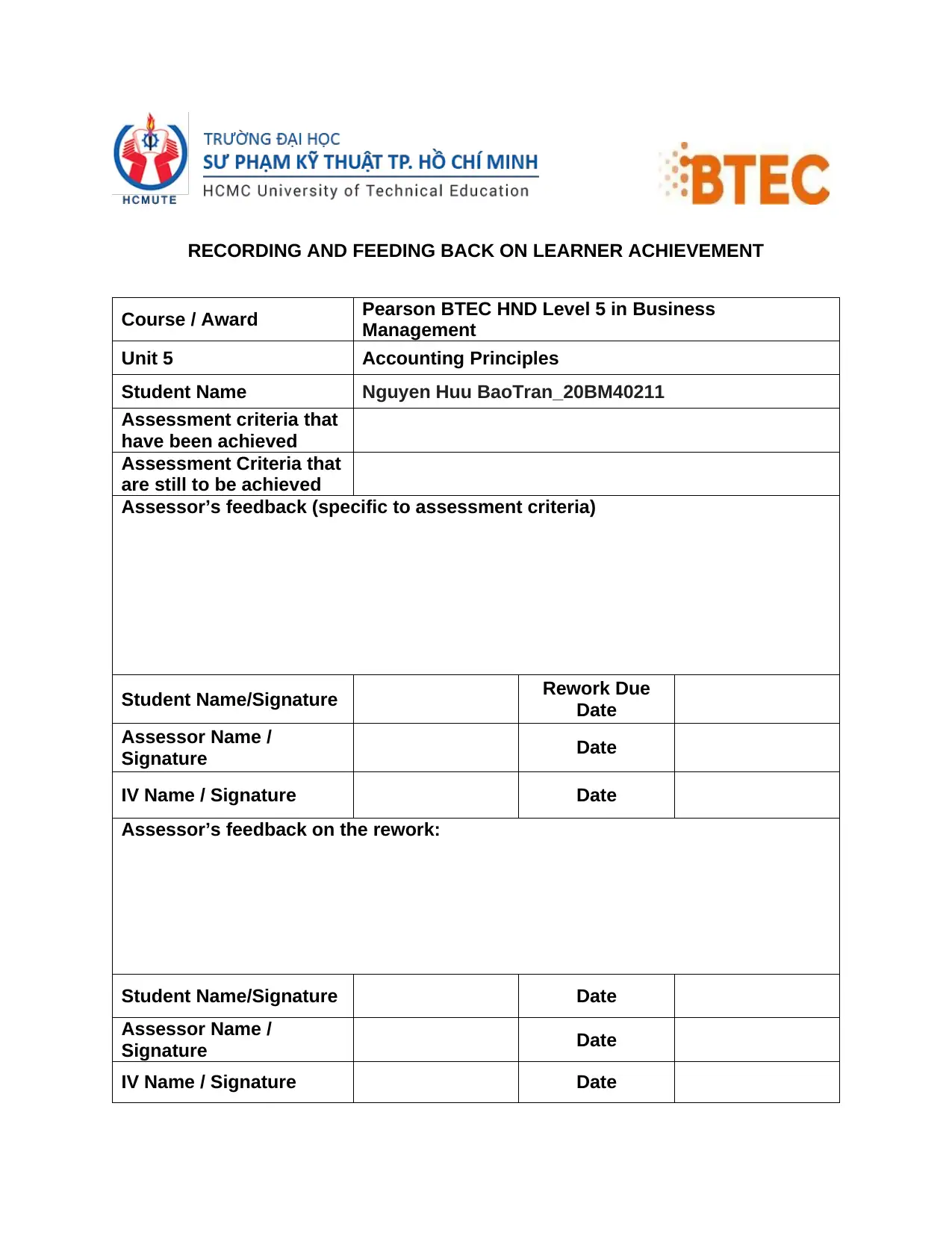
RECORDING AND FEEDING BACK ON LEARNER ACHIEVEMENT
Course / Award Pearson BTEC HND Level 5 in Business
Management
Unit 5 Accounting Principles
Student Name Nguyen Huu BaoTran_20BM40211
Assessment criteria that
have been achieved
Assessment Criteria that
are still to be achieved
Assessor’s feedback (specific to assessment criteria)
Student Name/Signature Rework Due
Date
Assessor Name /
Signature Date
IV Name / Signature Date
Assessor’s feedback on the rework:
Student Name/Signature Date
Assessor Name /
Signature Date
IV Name / Signature Date
Course / Award Pearson BTEC HND Level 5 in Business
Management
Unit 5 Accounting Principles
Student Name Nguyen Huu BaoTran_20BM40211
Assessment criteria that
have been achieved
Assessment Criteria that
are still to be achieved
Assessor’s feedback (specific to assessment criteria)
Student Name/Signature Rework Due
Date
Assessor Name /
Signature Date
IV Name / Signature Date
Assessor’s feedback on the rework:
Student Name/Signature Date
Assessor Name /
Signature Date
IV Name / Signature Date
Paraphrase This Document
Need a fresh take? Get an instant paraphrase of this document with our AI Paraphraser
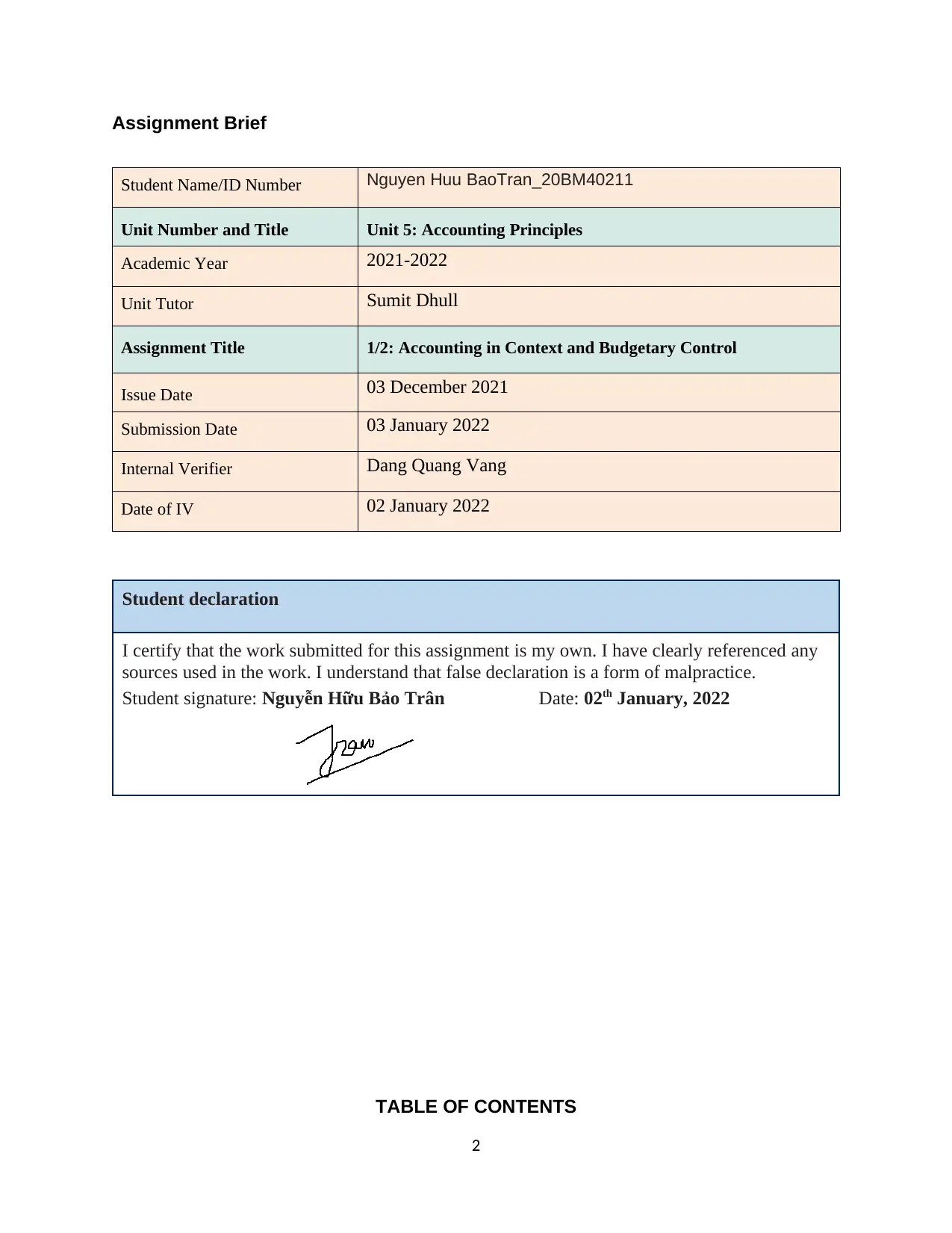
Assignment Brief
Student Name/ID Number Nguyen Huu BaoTran_20BM40211
Unit Number and Title Unit 5: Accounting Principles
Academic Year 2021-2022
Unit Tutor Sumit Dhull
Assignment Title 1/2: Accounting in Context and Budgetary Control
Issue Date 03 December 2021
Submission Date 03 January 2022
Internal Verifier Dang Quang Vang
Date of IV 02 January 2022
Student declaration
I certify that the work submitted for this assignment is my own. I have clearly referenced any
sources used in the work. I understand that false declaration is a form of malpractice.
Student signature: Nguyễn Hữu Bảo Trân Date: 02th January, 2022
TABLE OF CONTENTS
2
Student Name/ID Number Nguyen Huu BaoTran_20BM40211
Unit Number and Title Unit 5: Accounting Principles
Academic Year 2021-2022
Unit Tutor Sumit Dhull
Assignment Title 1/2: Accounting in Context and Budgetary Control
Issue Date 03 December 2021
Submission Date 03 January 2022
Internal Verifier Dang Quang Vang
Date of IV 02 January 2022
Student declaration
I certify that the work submitted for this assignment is my own. I have clearly referenced any
sources used in the work. I understand that false declaration is a form of malpractice.
Student signature: Nguyễn Hữu Bảo Trân Date: 02th January, 2022
TABLE OF CONTENTS
2
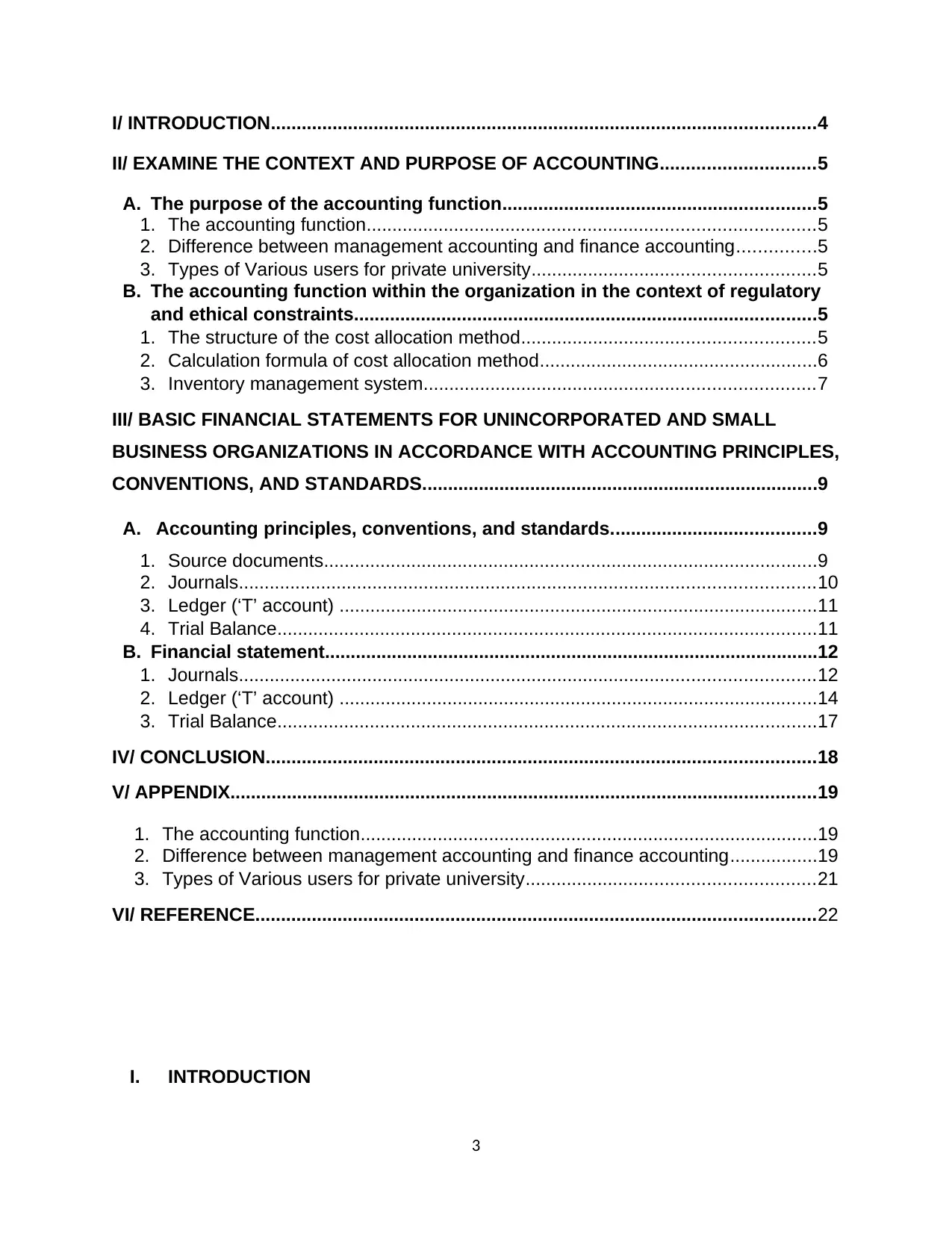
I/ INTRODUCTION..........................................................................................................4
II/ EXAMINE THE CONTEXT AND PURPOSE OF ACCOUNTING..............................5
A. The purpose of the accounting function.............................................................5
1. The accounting function.......................................................................................5
2. Difference between management accounting and finance accounting...............5
3. Types of Various users for private university.......................................................5
B. The accounting function within the organization in the context of regulatory
and ethical constraints..........................................................................................5
1. The structure of the cost allocation method.........................................................5
2. Calculation formula of cost allocation method......................................................6
3. Inventory management system............................................................................7
III/ BASIC FINANCIAL STATEMENTS FOR UNINCORPORATED AND SMALL
BUSINESS ORGANIZATIONS IN ACCORDANCE WITH ACCOUNTING PRINCIPLES,
CONVENTIONS, AND STANDARDS.............................................................................9
A. Accounting principles, conventions, and standards........................................9
1. Source documents................................................................................................9
2. Journals................................................................................................................10
3. Ledger (‘T’ account) .............................................................................................11
4. Trial Balance.........................................................................................................11
B. Financial statement................................................................................................12
1. Journals................................................................................................................12
2. Ledger (‘T’ account) .............................................................................................14
3. Trial Balance.........................................................................................................17
IV/ CONCLUSION...........................................................................................................18
V/ APPENDIX..................................................................................................................19
1. The accounting function.........................................................................................19
2. Difference between management accounting and finance accounting.................19
3. Types of Various users for private university........................................................21
VI/ REFERENCE.............................................................................................................22
I. INTRODUCTION
3
II/ EXAMINE THE CONTEXT AND PURPOSE OF ACCOUNTING..............................5
A. The purpose of the accounting function.............................................................5
1. The accounting function.......................................................................................5
2. Difference between management accounting and finance accounting...............5
3. Types of Various users for private university.......................................................5
B. The accounting function within the organization in the context of regulatory
and ethical constraints..........................................................................................5
1. The structure of the cost allocation method.........................................................5
2. Calculation formula of cost allocation method......................................................6
3. Inventory management system............................................................................7
III/ BASIC FINANCIAL STATEMENTS FOR UNINCORPORATED AND SMALL
BUSINESS ORGANIZATIONS IN ACCORDANCE WITH ACCOUNTING PRINCIPLES,
CONVENTIONS, AND STANDARDS.............................................................................9
A. Accounting principles, conventions, and standards........................................9
1. Source documents................................................................................................9
2. Journals................................................................................................................10
3. Ledger (‘T’ account) .............................................................................................11
4. Trial Balance.........................................................................................................11
B. Financial statement................................................................................................12
1. Journals................................................................................................................12
2. Ledger (‘T’ account) .............................................................................................14
3. Trial Balance.........................................................................................................17
IV/ CONCLUSION...........................................................................................................18
V/ APPENDIX..................................................................................................................19
1. The accounting function.........................................................................................19
2. Difference between management accounting and finance accounting.................19
3. Types of Various users for private university........................................................21
VI/ REFERENCE.............................................................................................................22
I. INTRODUCTION
3
⊘ This is a preview!⊘
Do you want full access?
Subscribe today to unlock all pages.

Trusted by 1+ million students worldwide
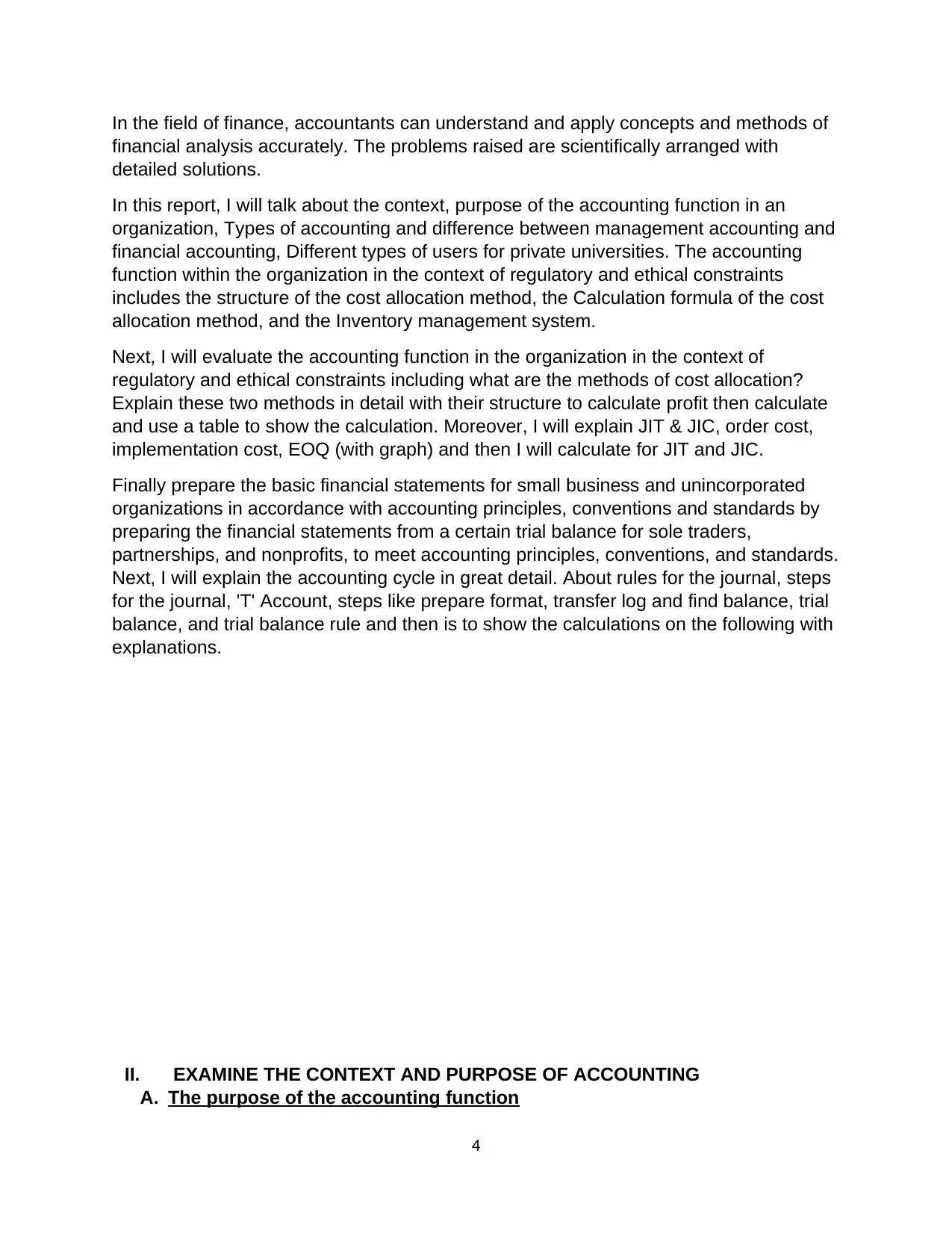
In the field of finance, accountants can understand and apply concepts and methods of
financial analysis accurately. The problems raised are scientifically arranged with
detailed solutions.
In this report, I will talk about the context, purpose of the accounting function in an
organization, Types of accounting and difference between management accounting and
financial accounting, Different types of users for private universities. The accounting
function within the organization in the context of regulatory and ethical constraints
includes the structure of the cost allocation method, the Calculation formula of the cost
allocation method, and the Inventory management system.
Next, I will evaluate the accounting function in the organization in the context of
regulatory and ethical constraints including what are the methods of cost allocation?
Explain these two methods in detail with their structure to calculate profit then calculate
and use a table to show the calculation. Moreover, I will explain JIT & JIC, order cost,
implementation cost, EOQ (with graph) and then I will calculate for JIT and JIC.
Finally prepare the basic financial statements for small business and unincorporated
organizations in accordance with accounting principles, conventions and standards by
preparing the financial statements from a certain trial balance for sole traders,
partnerships, and nonprofits, to meet accounting principles, conventions, and standards.
Next, I will explain the accounting cycle in great detail. About rules for the journal, steps
for the journal, 'T' Account, steps like prepare format, transfer log and find balance, trial
balance, and trial balance rule and then is to show the calculations on the following with
explanations.
II. EXAMINE THE CONTEXT AND PURPOSE OF ACCOUNTING
A. The purpose of the accounting function
4
financial analysis accurately. The problems raised are scientifically arranged with
detailed solutions.
In this report, I will talk about the context, purpose of the accounting function in an
organization, Types of accounting and difference between management accounting and
financial accounting, Different types of users for private universities. The accounting
function within the organization in the context of regulatory and ethical constraints
includes the structure of the cost allocation method, the Calculation formula of the cost
allocation method, and the Inventory management system.
Next, I will evaluate the accounting function in the organization in the context of
regulatory and ethical constraints including what are the methods of cost allocation?
Explain these two methods in detail with their structure to calculate profit then calculate
and use a table to show the calculation. Moreover, I will explain JIT & JIC, order cost,
implementation cost, EOQ (with graph) and then I will calculate for JIT and JIC.
Finally prepare the basic financial statements for small business and unincorporated
organizations in accordance with accounting principles, conventions and standards by
preparing the financial statements from a certain trial balance for sole traders,
partnerships, and nonprofits, to meet accounting principles, conventions, and standards.
Next, I will explain the accounting cycle in great detail. About rules for the journal, steps
for the journal, 'T' Account, steps like prepare format, transfer log and find balance, trial
balance, and trial balance rule and then is to show the calculations on the following with
explanations.
II. EXAMINE THE CONTEXT AND PURPOSE OF ACCOUNTING
A. The purpose of the accounting function
4
Paraphrase This Document
Need a fresh take? Get an instant paraphrase of this document with our AI Paraphraser
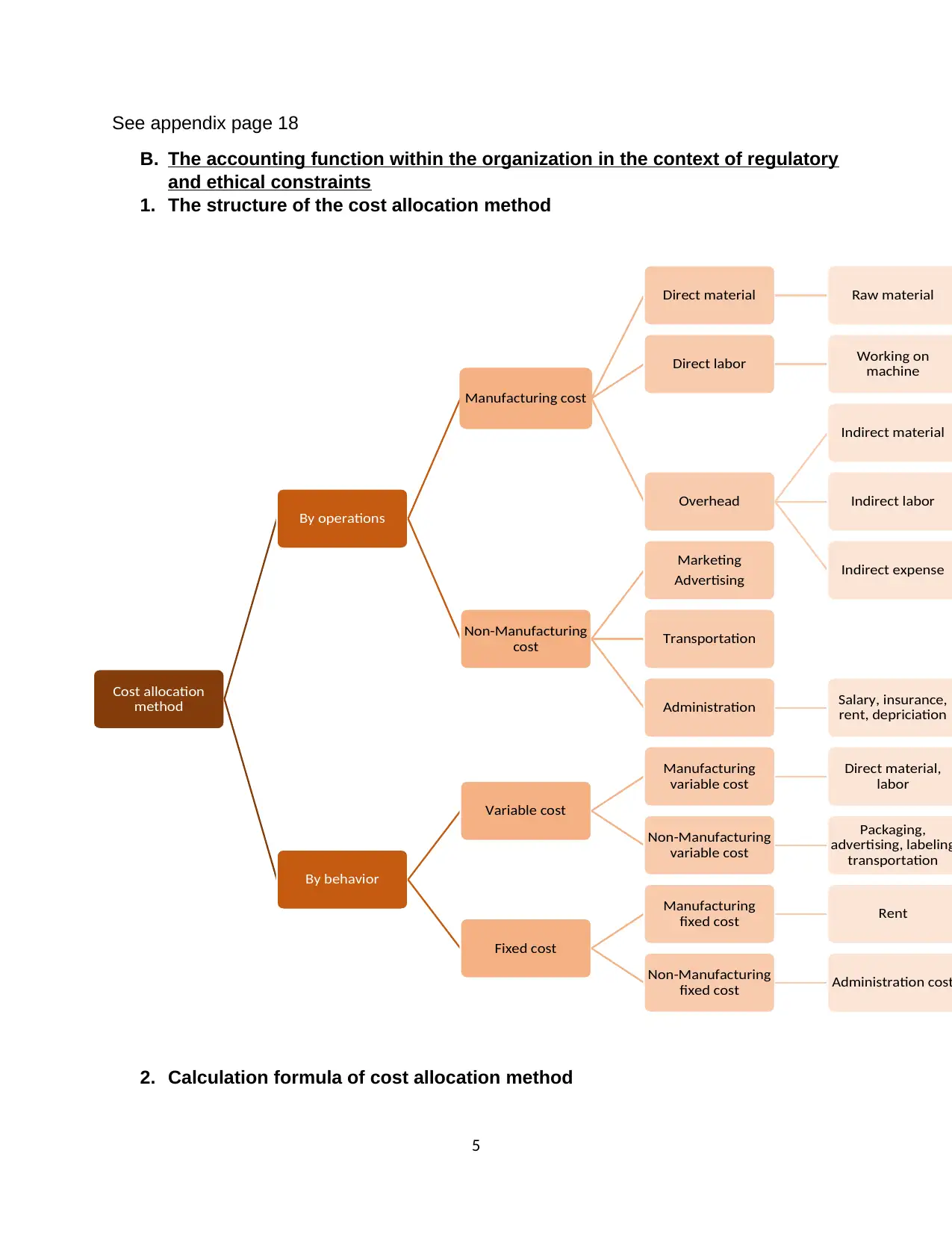
See appendix page 18
B. The accounting function within the organization in the context of regulatory
and ethical constraints
1. The structure of the cost allocation method
2. Calculation formula of cost allocation method
5
Cost allocation
method
By operations
Manufacturing cost
Direct material Raw material
Direct labor Working on
machine
Overhead
Indirect material
Indirect labor
Indirect expense
Non-Manufacturing
cost
Marketing
Advertising
Transportation
Administration Salary, insurance,
rent, depriciation
By behavior
Variable cost
Manufacturing
variable cost
Direct material,
labor
Non-Manufacturing
variable cost
Packaging,
advertising, labeling
transportation
Fixed cost
Manufacturing
fixed cost Rent
Non-Manufacturing
fixed cost Administration cost
B. The accounting function within the organization in the context of regulatory
and ethical constraints
1. The structure of the cost allocation method
2. Calculation formula of cost allocation method
5
Cost allocation
method
By operations
Manufacturing cost
Direct material Raw material
Direct labor Working on
machine
Overhead
Indirect material
Indirect labor
Indirect expense
Non-Manufacturing
cost
Marketing
Advertising
Transportation
Administration Salary, insurance,
rent, depriciation
By behavior
Variable cost
Manufacturing
variable cost
Direct material,
labor
Non-Manufacturing
variable cost
Packaging,
advertising, labeling
transportation
Fixed cost
Manufacturing
fixed cost Rent
Non-Manufacturing
fixed cost Administration cost
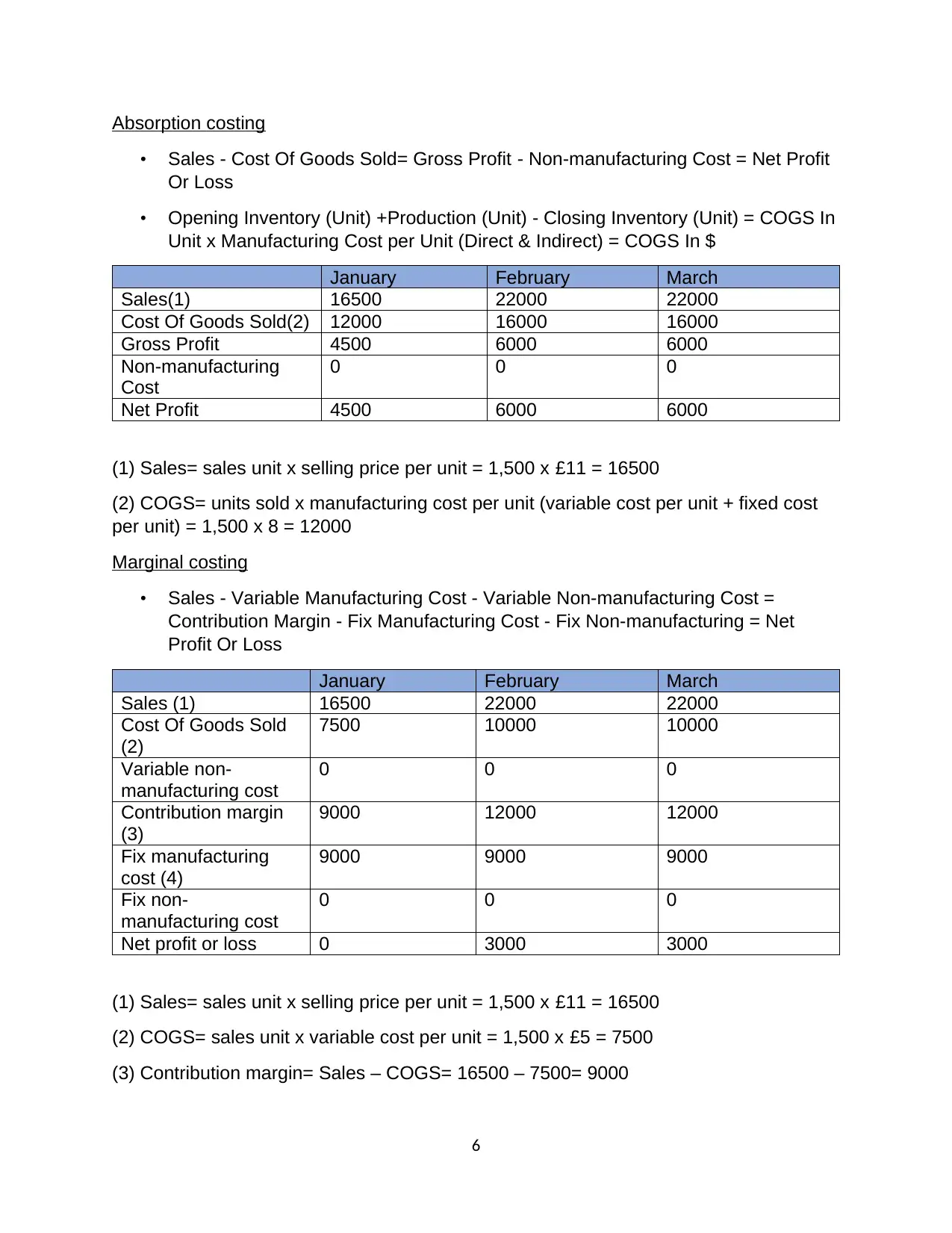
Absorption costing
• Sales - Cost Of Goods Sold= Gross Profit - Non-manufacturing Cost = Net Profit
Or Loss
• Opening Inventory (Unit) +Production (Unit) - Closing Inventory (Unit) = COGS In
Unit x Manufacturing Cost per Unit (Direct & Indirect) = COGS In $
January February March
Sales(1) 16500 22000 22000
Cost Of Goods Sold(2) 12000 16000 16000
Gross Profit 4500 6000 6000
Non-manufacturing
Cost
0 0 0
Net Profit 4500 6000 6000
(1) Sales= sales unit x selling price per unit = 1,500 x £11 = 16500
(2) COGS= units sold x manufacturing cost per unit (variable cost per unit + fixed cost
per unit) = 1,500 x 8 = 12000
Marginal costing
• Sales - Variable Manufacturing Cost - Variable Non-manufacturing Cost =
Contribution Margin - Fix Manufacturing Cost - Fix Non-manufacturing = Net
Profit Or Loss
January February March
Sales (1) 16500 22000 22000
Cost Of Goods Sold
(2)
7500 10000 10000
Variable non-
manufacturing cost
0 0 0
Contribution margin
(3)
9000 12000 12000
Fix manufacturing
cost (4)
9000 9000 9000
Fix non-
manufacturing cost
0 0 0
Net profit or loss 0 3000 3000
(1) Sales= sales unit x selling price per unit = 1,500 x £11 = 16500
(2) COGS= sales unit x variable cost per unit = 1,500 x £5 = 7500
(3) Contribution margin= Sales – COGS= 16500 – 7500= 9000
6
• Sales - Cost Of Goods Sold= Gross Profit - Non-manufacturing Cost = Net Profit
Or Loss
• Opening Inventory (Unit) +Production (Unit) - Closing Inventory (Unit) = COGS In
Unit x Manufacturing Cost per Unit (Direct & Indirect) = COGS In $
January February March
Sales(1) 16500 22000 22000
Cost Of Goods Sold(2) 12000 16000 16000
Gross Profit 4500 6000 6000
Non-manufacturing
Cost
0 0 0
Net Profit 4500 6000 6000
(1) Sales= sales unit x selling price per unit = 1,500 x £11 = 16500
(2) COGS= units sold x manufacturing cost per unit (variable cost per unit + fixed cost
per unit) = 1,500 x 8 = 12000
Marginal costing
• Sales - Variable Manufacturing Cost - Variable Non-manufacturing Cost =
Contribution Margin - Fix Manufacturing Cost - Fix Non-manufacturing = Net
Profit Or Loss
January February March
Sales (1) 16500 22000 22000
Cost Of Goods Sold
(2)
7500 10000 10000
Variable non-
manufacturing cost
0 0 0
Contribution margin
(3)
9000 12000 12000
Fix manufacturing
cost (4)
9000 9000 9000
Fix non-
manufacturing cost
0 0 0
Net profit or loss 0 3000 3000
(1) Sales= sales unit x selling price per unit = 1,500 x £11 = 16500
(2) COGS= sales unit x variable cost per unit = 1,500 x £5 = 7500
(3) Contribution margin= Sales – COGS= 16500 – 7500= 9000
6
⊘ This is a preview!⊘
Do you want full access?
Subscribe today to unlock all pages.

Trusted by 1+ million students worldwide
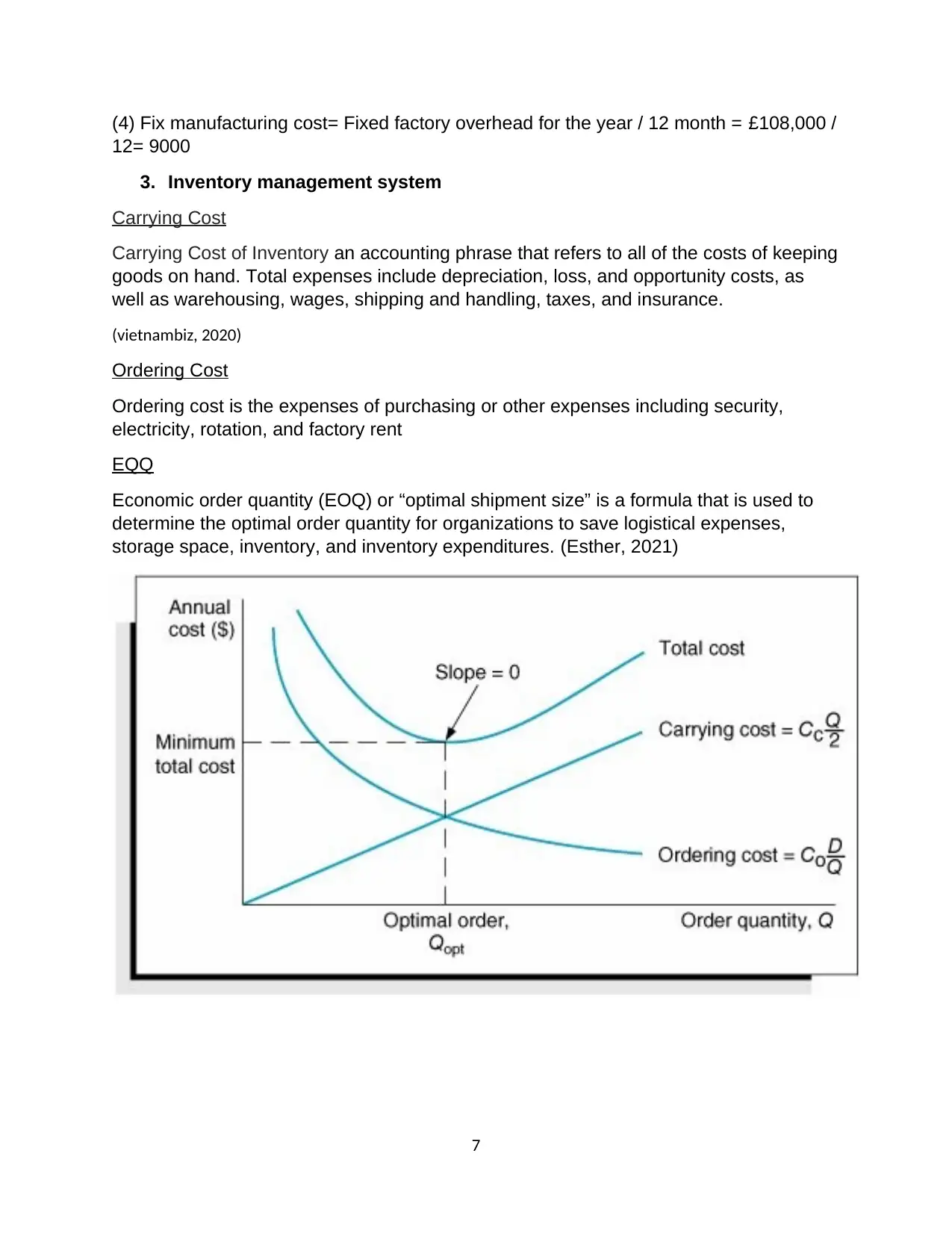
(4) Fix manufacturing cost= Fixed factory overhead for the year / 12 month = £108,000 /
12= 9000
3. Inventory management system
Carrying Cost
Carrying Cost of Inventory an accounting phrase that refers to all of the costs of keeping
goods on hand. Total expenses include depreciation, loss, and opportunity costs, as
well as warehousing, wages, shipping and handling, taxes, and insurance.
(vietnambiz, 2020)
Ordering Cost
Ordering cost is the expenses of purchasing or other expenses including security,
electricity, rotation, and factory rent
EQQ
Economic order quantity (EOQ) or “optimal shipment size” is a formula that is used to
determine the optimal order quantity for organizations to save logistical expenses,
storage space, inventory, and inventory expenditures. (Esther, 2021)
7
12= 9000
3. Inventory management system
Carrying Cost
Carrying Cost of Inventory an accounting phrase that refers to all of the costs of keeping
goods on hand. Total expenses include depreciation, loss, and opportunity costs, as
well as warehousing, wages, shipping and handling, taxes, and insurance.
(vietnambiz, 2020)
Ordering Cost
Ordering cost is the expenses of purchasing or other expenses including security,
electricity, rotation, and factory rent
EQQ
Economic order quantity (EOQ) or “optimal shipment size” is a formula that is used to
determine the optimal order quantity for organizations to save logistical expenses,
storage space, inventory, and inventory expenditures. (Esther, 2021)
7
Paraphrase This Document
Need a fresh take? Get an instant paraphrase of this document with our AI Paraphraser
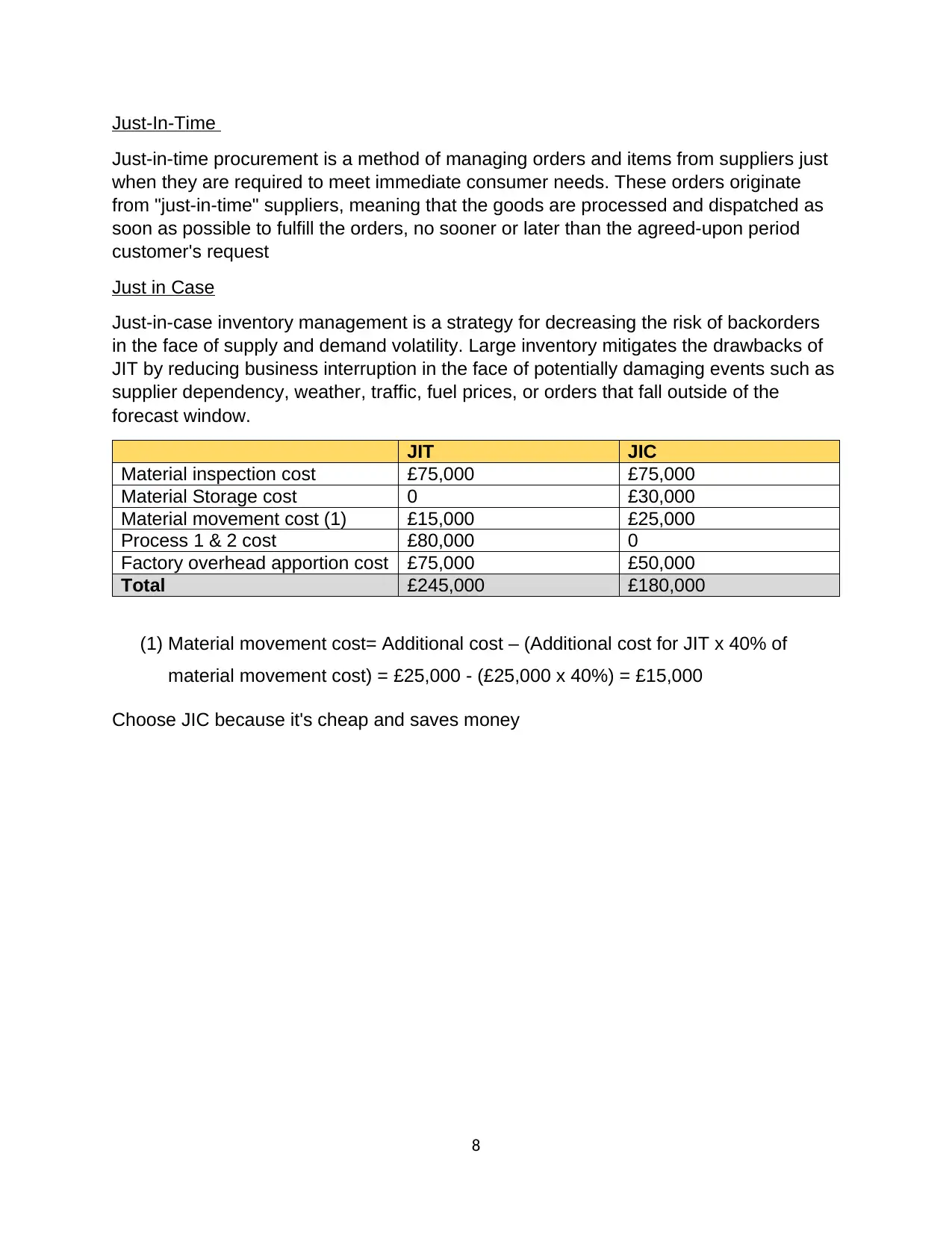
Just-In-Time
Just-in-time procurement is a method of managing orders and items from suppliers just
when they are required to meet immediate consumer needs. These orders originate
from "just-in-time" suppliers, meaning that the goods are processed and dispatched as
soon as possible to fulfill the orders, no sooner or later than the agreed-upon period
customer's request
Just in Case
Just-in-case inventory management is a strategy for decreasing the risk of backorders
in the face of supply and demand volatility. Large inventory mitigates the drawbacks of
JIT by reducing business interruption in the face of potentially damaging events such as
supplier dependency, weather, traffic, fuel prices, or orders that fall outside of the
forecast window.
JIT JIC
Material inspection cost £75,000 £75,000
Material Storage cost 0 £30,000
Material movement cost (1) £15,000 £25,000
Process 1 & 2 cost £80,000 0
Factory overhead apportion cost £75,000 £50,000
Total £245,000 £180,000
(1) Material movement cost= Additional cost – (Additional cost for JIT x 40% of
material movement cost) = £25,000 - (£25,000 x 40%) = £15,000
Choose JIC because it's cheap and saves money
8
Just-in-time procurement is a method of managing orders and items from suppliers just
when they are required to meet immediate consumer needs. These orders originate
from "just-in-time" suppliers, meaning that the goods are processed and dispatched as
soon as possible to fulfill the orders, no sooner or later than the agreed-upon period
customer's request
Just in Case
Just-in-case inventory management is a strategy for decreasing the risk of backorders
in the face of supply and demand volatility. Large inventory mitigates the drawbacks of
JIT by reducing business interruption in the face of potentially damaging events such as
supplier dependency, weather, traffic, fuel prices, or orders that fall outside of the
forecast window.
JIT JIC
Material inspection cost £75,000 £75,000
Material Storage cost 0 £30,000
Material movement cost (1) £15,000 £25,000
Process 1 & 2 cost £80,000 0
Factory overhead apportion cost £75,000 £50,000
Total £245,000 £180,000
(1) Material movement cost= Additional cost – (Additional cost for JIT x 40% of
material movement cost) = £25,000 - (£25,000 x 40%) = £15,000
Choose JIC because it's cheap and saves money
8
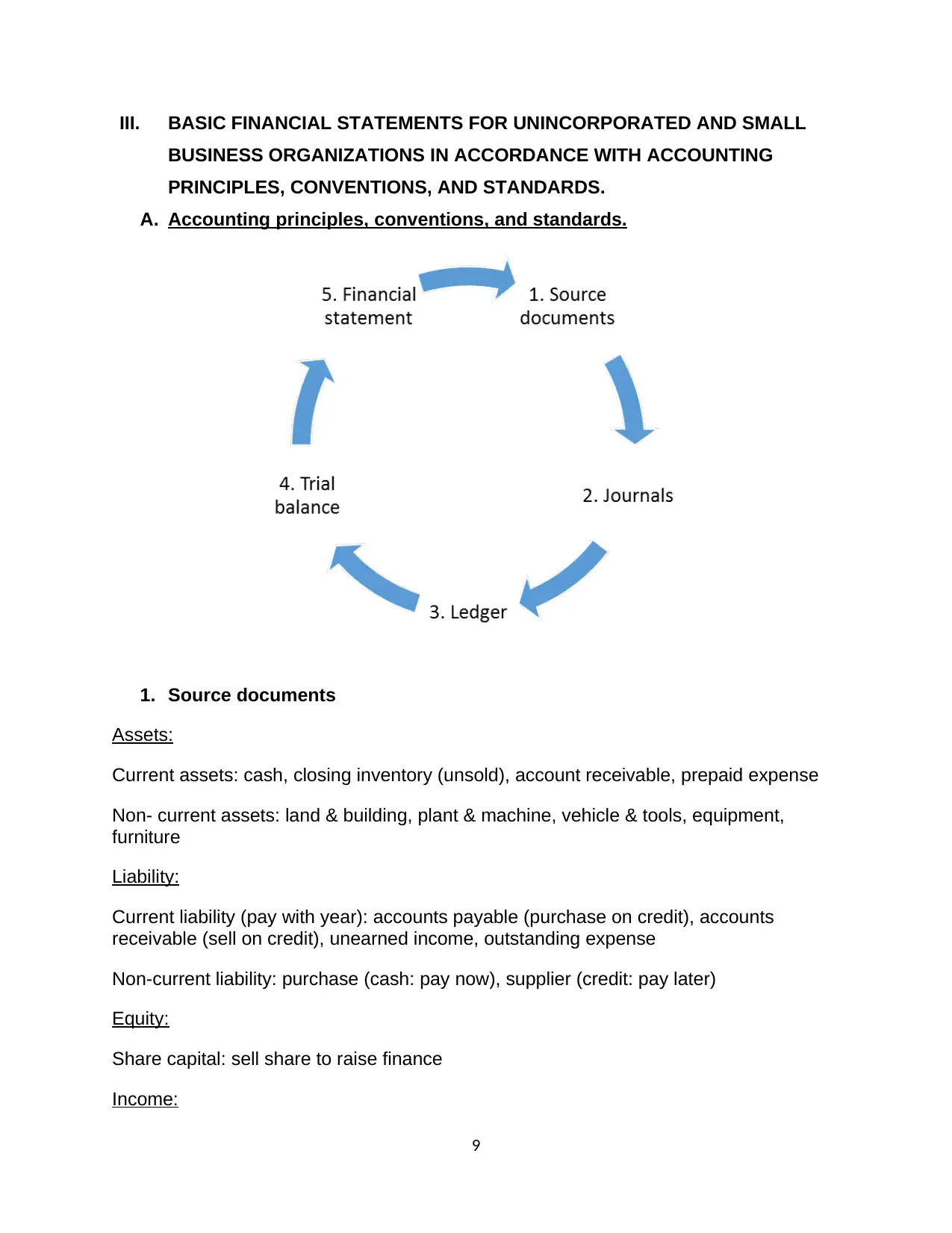
III. BASIC FINANCIAL STATEMENTS FOR UNINCORPORATED AND SMALL
BUSINESS ORGANIZATIONS IN ACCORDANCE WITH ACCOUNTING
PRINCIPLES, CONVENTIONS, AND STANDARDS.
A. Accounting principles, conventions, and standards.
1. Source documents
Assets:
Current assets: cash, closing inventory (unsold), account receivable, prepaid expense
Non- current assets: land & building, plant & machine, vehicle & tools, equipment,
furniture
Liability:
Current liability (pay with year): accounts payable (purchase on credit), accounts
receivable (sell on credit), unearned income, outstanding expense
Non-current liability: purchase (cash: pay now), supplier (credit: pay later)
Equity:
Share capital: sell share to raise finance
Income:
9
BUSINESS ORGANIZATIONS IN ACCORDANCE WITH ACCOUNTING
PRINCIPLES, CONVENTIONS, AND STANDARDS.
A. Accounting principles, conventions, and standards.
1. Source documents
Assets:
Current assets: cash, closing inventory (unsold), account receivable, prepaid expense
Non- current assets: land & building, plant & machine, vehicle & tools, equipment,
furniture
Liability:
Current liability (pay with year): accounts payable (purchase on credit), accounts
receivable (sell on credit), unearned income, outstanding expense
Non-current liability: purchase (cash: pay now), supplier (credit: pay later)
Equity:
Share capital: sell share to raise finance
Income:
9
⊘ This is a preview!⊘
Do you want full access?
Subscribe today to unlock all pages.

Trusted by 1+ million students worldwide
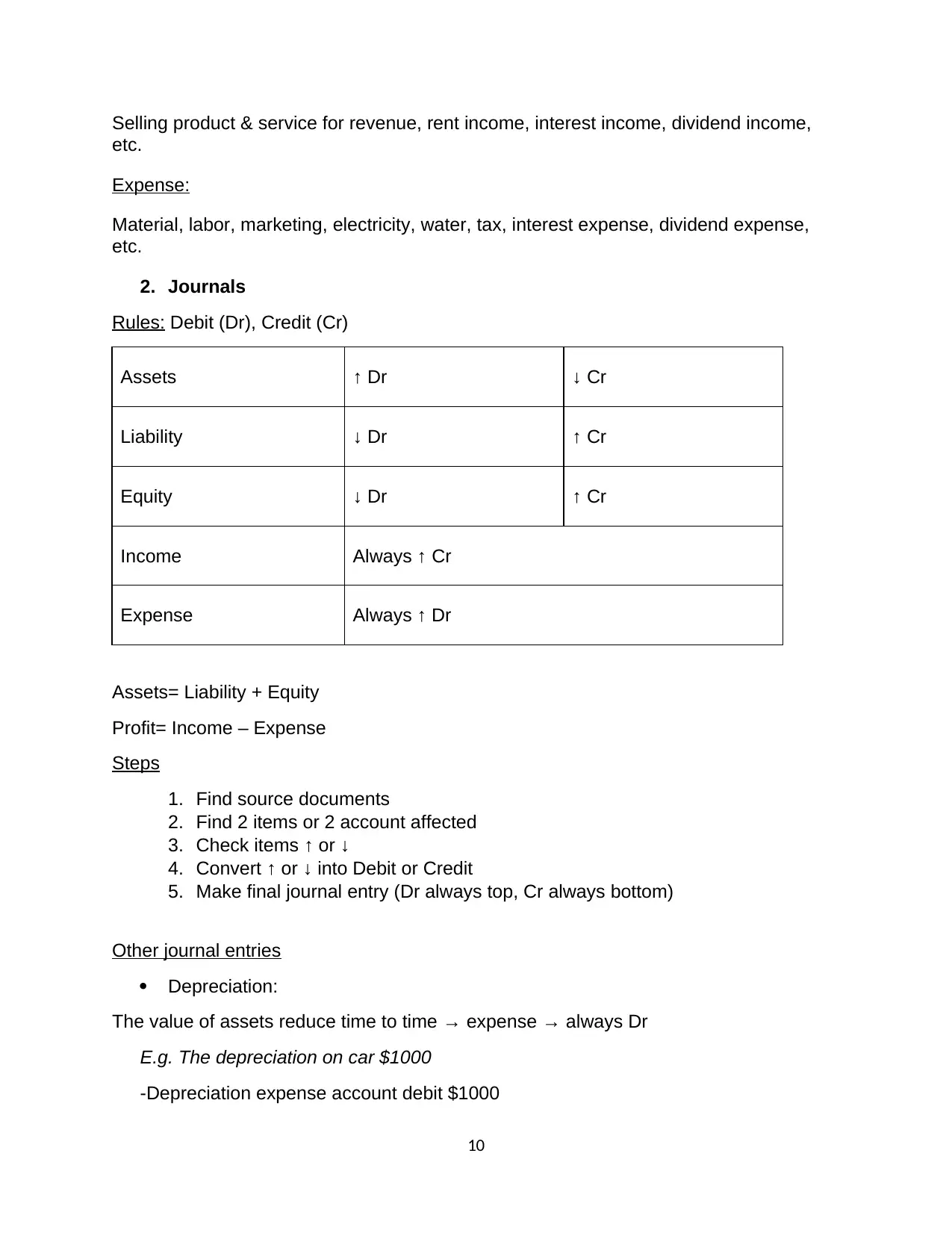
Selling product & service for revenue, rent income, interest income, dividend income,
etc.
Expense:
Material, labor, marketing, electricity, water, tax, interest expense, dividend expense,
etc.
2. Journals
Rules: Debit (Dr), Credit (Cr)
Assets ↑ Dr ↓ Cr
Liability ↓ Dr ↑ Cr
Equity ↓ Dr ↑ Cr
Income Always ↑ Cr
Expense Always ↑ Dr
Assets= Liability + Equity
Profit= Income – Expense
Steps
1. Find source documents
2. Find 2 items or 2 account affected
3. Check items ↑ or ↓
4. Convert ↑ or ↓ into Debit or Credit
5. Make final journal entry (Dr always top, Cr always bottom)
Other journal entries
Depreciation:
The value of assets reduce time to time → expense → always Dr
E.g. The depreciation on car $1000
-Depreciation expense account debit $1000
10
etc.
Expense:
Material, labor, marketing, electricity, water, tax, interest expense, dividend expense,
etc.
2. Journals
Rules: Debit (Dr), Credit (Cr)
Assets ↑ Dr ↓ Cr
Liability ↓ Dr ↑ Cr
Equity ↓ Dr ↑ Cr
Income Always ↑ Cr
Expense Always ↑ Dr
Assets= Liability + Equity
Profit= Income – Expense
Steps
1. Find source documents
2. Find 2 items or 2 account affected
3. Check items ↑ or ↓
4. Convert ↑ or ↓ into Debit or Credit
5. Make final journal entry (Dr always top, Cr always bottom)
Other journal entries
Depreciation:
The value of assets reduce time to time → expense → always Dr
E.g. The depreciation on car $1000
-Depreciation expense account debit $1000
10
Paraphrase This Document
Need a fresh take? Get an instant paraphrase of this document with our AI Paraphraser
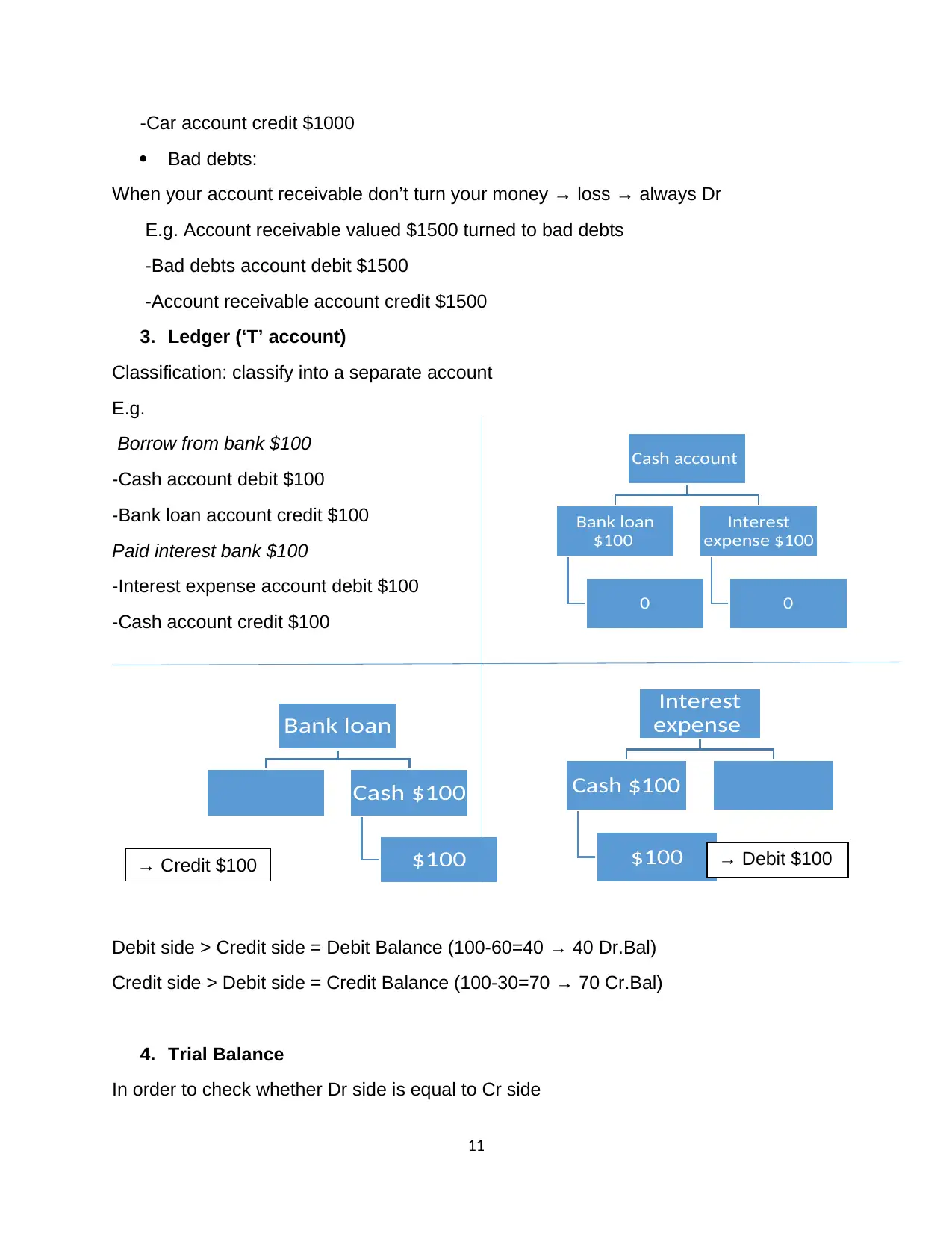
-Car account credit $1000
Bad debts:
When your account receivable don’t turn your money → loss → always Dr
E.g. Account receivable valued $1500 turned to bad debts
-Bad debts account debit $1500
-Account receivable account credit $1500
3. Ledger (‘T’ account)
Classification: classify into a separate account
E.g.
Borrow from bank $100
-Cash account debit $100
-Bank loan account credit $100
Paid interest bank $100
-Interest expense account debit $100
-Cash account credit $100
Debit side > Credit side = Debit Balance (100-60=40 → 40 Dr.Bal)
Credit side > Debit side = Credit Balance (100-30=70 → 70 Cr.Bal)
4. Trial Balance
In order to check whether Dr side is equal to Cr side
11
Cash account
Bank loan
$100
0
Interest
expense $100
0
Bank loan
Cash $100
$100
Interest
expense
Cash $100
$100→ Credit $100 → Debit $100
Bad debts:
When your account receivable don’t turn your money → loss → always Dr
E.g. Account receivable valued $1500 turned to bad debts
-Bad debts account debit $1500
-Account receivable account credit $1500
3. Ledger (‘T’ account)
Classification: classify into a separate account
E.g.
Borrow from bank $100
-Cash account debit $100
-Bank loan account credit $100
Paid interest bank $100
-Interest expense account debit $100
-Cash account credit $100
Debit side > Credit side = Debit Balance (100-60=40 → 40 Dr.Bal)
Credit side > Debit side = Credit Balance (100-30=70 → 70 Cr.Bal)
4. Trial Balance
In order to check whether Dr side is equal to Cr side
11
Cash account
Bank loan
$100
0
Interest
expense $100
0
Bank loan
Cash $100
$100
Interest
expense
Cash $100
$100→ Credit $100 → Debit $100
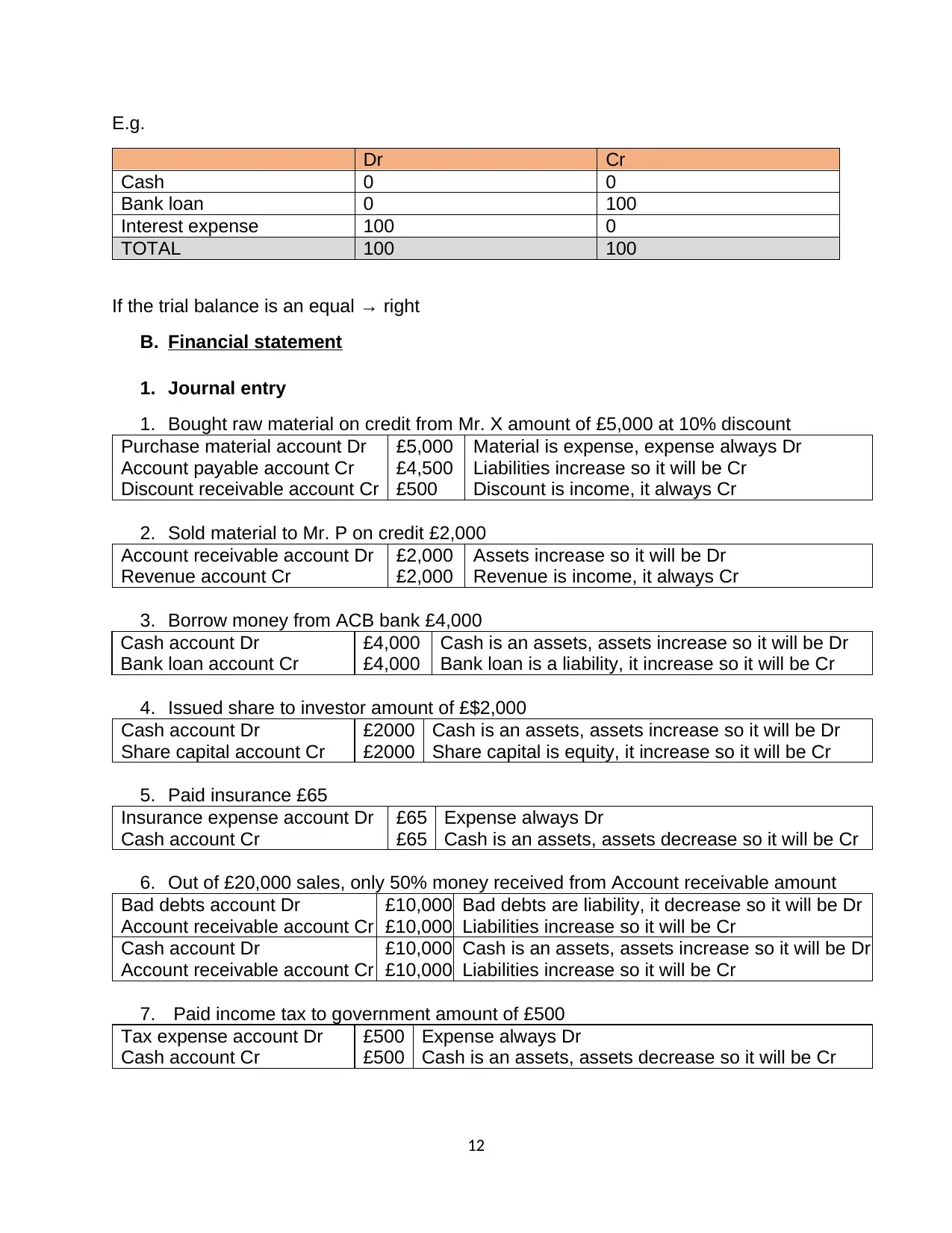
E.g.
Dr Cr
Cash 0 0
Bank loan 0 100
Interest expense 100 0
TOTAL 100 100
If the trial balance is an equal → right
B. Financial statement
1. Journal entry
1. Bought raw material on credit from Mr. X amount of £5,000 at 10% discount
Purchase material account Dr £5,000 Material is expense, expense always Dr
Account payable account Cr £4,500 Liabilities increase so it will be Cr
Discount receivable account Cr £500 Discount is income, it always Cr
2. Sold material to Mr. P on credit £2,000
Account receivable account Dr £2,000 Assets increase so it will be Dr
Revenue account Cr £2,000 Revenue is income, it always Cr
3. Borrow money from ACB bank £4,000
Cash account Dr £4,000 Cash is an assets, assets increase so it will be Dr
Bank loan account Cr £4,000 Bank loan is a liability, it increase so it will be Cr
4. Issued share to investor amount of £$2,000
Cash account Dr £2000 Cash is an assets, assets increase so it will be Dr
Share capital account Cr £2000 Share capital is equity, it increase so it will be Cr
5. Paid insurance £65
Insurance expense account Dr £65 Expense always Dr
Cash account Cr £65 Cash is an assets, assets decrease so it will be Cr
6. Out of £20,000 sales, only 50% money received from Account receivable amount
Bad debts account Dr £10,000 Bad debts are liability, it decrease so it will be Dr
Account receivable account Cr £10,000 Liabilities increase so it will be Cr
Cash account Dr £10,000 Cash is an assets, assets increase so it will be Dr
Account receivable account Cr £10,000 Liabilities increase so it will be Cr
7. Paid income tax to government amount of £500
Tax expense account Dr £500 Expense always Dr
Cash account Cr £500 Cash is an assets, assets decrease so it will be Cr
12
Dr Cr
Cash 0 0
Bank loan 0 100
Interest expense 100 0
TOTAL 100 100
If the trial balance is an equal → right
B. Financial statement
1. Journal entry
1. Bought raw material on credit from Mr. X amount of £5,000 at 10% discount
Purchase material account Dr £5,000 Material is expense, expense always Dr
Account payable account Cr £4,500 Liabilities increase so it will be Cr
Discount receivable account Cr £500 Discount is income, it always Cr
2. Sold material to Mr. P on credit £2,000
Account receivable account Dr £2,000 Assets increase so it will be Dr
Revenue account Cr £2,000 Revenue is income, it always Cr
3. Borrow money from ACB bank £4,000
Cash account Dr £4,000 Cash is an assets, assets increase so it will be Dr
Bank loan account Cr £4,000 Bank loan is a liability, it increase so it will be Cr
4. Issued share to investor amount of £$2,000
Cash account Dr £2000 Cash is an assets, assets increase so it will be Dr
Share capital account Cr £2000 Share capital is equity, it increase so it will be Cr
5. Paid insurance £65
Insurance expense account Dr £65 Expense always Dr
Cash account Cr £65 Cash is an assets, assets decrease so it will be Cr
6. Out of £20,000 sales, only 50% money received from Account receivable amount
Bad debts account Dr £10,000 Bad debts are liability, it decrease so it will be Dr
Account receivable account Cr £10,000 Liabilities increase so it will be Cr
Cash account Dr £10,000 Cash is an assets, assets increase so it will be Dr
Account receivable account Cr £10,000 Liabilities increase so it will be Cr
7. Paid income tax to government amount of £500
Tax expense account Dr £500 Expense always Dr
Cash account Cr £500 Cash is an assets, assets decrease so it will be Cr
12
⊘ This is a preview!⊘
Do you want full access?
Subscribe today to unlock all pages.

Trusted by 1+ million students worldwide
1 out of 22
Related Documents
Your All-in-One AI-Powered Toolkit for Academic Success.
+13062052269
info@desklib.com
Available 24*7 on WhatsApp / Email
![[object Object]](/_next/static/media/star-bottom.7253800d.svg)
Unlock your academic potential
Copyright © 2020–2025 A2Z Services. All Rights Reserved. Developed and managed by ZUCOL.




